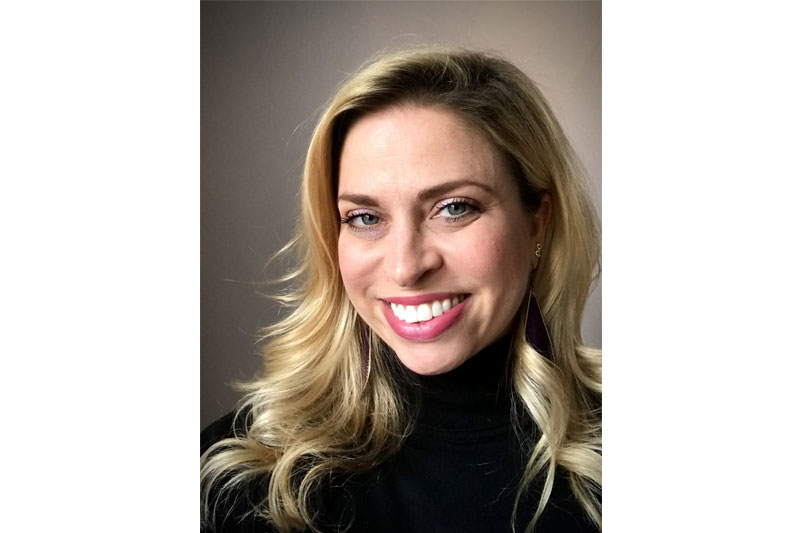Meet the NYCHG Members: Ashley Bradford of Singer/M. Tucker
Learn more about our Member Ashley Bradford!
Home » Meet the NYCHG Members: Ashley Bradford of Singer/M. Tucker

By: Ashley Bradford
After a dance career, Ashley Bradford pirouetted her way into the restaurant world as a full-time hospitality professional in Charlotte, North Carolina. “I would joke that I got into restaurants because I used to dance professionally and I was starving,” she says. She worked front-of-house jobs in Charlotte and later New York City before joining Singer/M. Tucker, the largest foodservice and equipment supplies dealer in Metro New York. There she acts as a partner to her clients, helping restaurants get the products they need at the prices they want. Her clients include Levain Bakery, Inday, Lola Taverna, and Cookshop.
Q: I’m sure you get this all the time, but what is your favorite restaurant in New York City?
Ashley Bradford: I feel like it’s always a good question because I feel like the experience of restaurants is so personal. Of my favorite experiences, I’d have to go with Per Se because it was just everything magical in the whole world. If I could go anywhere right now, though, it would be Corner Bistro. It’s got a neighborhood vibe — good beer and a great burger. When I worked in restaurants, it was a place to hide after a really long shift.
Q: You were a professional dancer before moving into hospitality. Are there any similarities between these two worlds?
AB: There are similarities. What attracted me to restaurants in the first place is the artistic inspiration of it. Chefs are similar to artistic directors and choreographers in that they’ve got these crazy cool ideas and then they need people around them who can break down the pieces and show them how to bring it all to fruition.
That’s where I come in. It’s everything from finding the right color, the right size, the right piece of equipment in support of their vision.
Q: How did you cross into the supplies side of the industry?
AB: I’d been in operations for a long time and I was starting to look for new challenges. Around that time, a good friend I had worked with in operations moved into the distribution side a couple of years before. We would meet up for a drink, and he would always say how much I would love that side of it.
I couldn’t see the creativity in it at first. Then I went with him to one of the restaurants he helped open and saw the tabletops, the flourishes, it was like a light switch went on and I thought, I’ve got to be on this side of things. And it was the best thing I’ve ever done. This is the best position I’ve ever had.
Q: What are the biggest lessons you’ve learned while doing this type of work?
AB: I think it’s seeing how unique our industry is. I already knew how diverse it can be going from space to space, but there are so many different needs restaurants have. It comes down to a million small choices, just very specific needs and preferences, from napkins to tabletops to stoneware and beyond.
The chef, the owner, the general manager, and the night porter will each have a different take on different products. We have to understand all these perspectives, and we have to know a little bit about everything so we can make sure the chef has that one special tong that’s only available through some particular distributor or importer. We have to know where and how to get them all these things.
One of our main values is that we go to the National Restaurant Association show and we are like sponges. We absorb EVERYTHING because you never know when a client is going to ask for something that is out of left field, like a request for a cutting-edge custom product.
Q: Do you have a particular process when working with new clients?
AB: It can be pure chaos at the beginning because it’s like any relationship — you’re getting to know what their needs are. And every operation is wildly different, so we need to adapt to each other’s delivery schedules.
We usually begin with the basics. So a restaurateur will call us for something specific because the chef has worked with us previously and wants to bring our relationship over to this operation. We start small and then over time, we’ve built up a relationship and learn where else we can help meet their needs. It’s relationship building.
My largest client came to me asking for a tiny whisk made by only one manufacturer and we had it. From there, we started handling their paper products. And later we moved into custom products and smallwares. I just did their last three openings. So it comes down to trust.
Q: Are there any common mistakes you’ve seen people make with their product or equipment needs over the years?
AB: I think the biggest money-saving pieces that they’re not always paying attention to are to-go packaging and disposables. It’s easy to overlook, but it’s a place they can save money.
I can always get their attention when I say, well, you may not think spending two cents or five cents more on a cutlery kit matters. But If you do one thousand packed meals a month and you’re saving five cents a meal, that’s huge savings over the course of a year.
That’s where we are able to help them navigate that world and work on their behalf in that capacity.
Q: Given your experience and your trained eye, are there instances where you, as a diner, can tell that a restaurant may not have worked with a partner like yourself?
AB: You can tell when someone has put a lot of thought, time, and energy into creating a diner experience that will keep people coming back. You can just tell when things were done with intention. A telltale sign they weren’t is if your food comes and it’s on plates that are just too big for their tables. As a result, diners are less likely to order more food and it’s not going to be a comfortable experience.
Personally, for me, it’s always the water glass. I run into this a lot — they give you a six-ounce water glass and it’s just too small. You’re leaving your customers sitting there half the time without enough water! And that also puts additional stress on your staff.
My colleagues and I, pre-COVID, were in all our restaurants on a weekly basis. We would sit and watch service and see what problems they were having, how that could be affecting the diner experience, and offer good solutions. So rather than infuriating a customer with an empty water glass, for example, we flag the issue and work on a fix for it.
Q: As you’re having these wide-ranging yet granular conversations, I would imagine you occasionally get asked to weigh in on topics that are beyond your immediate knowledge. How do you manage that situation?
AB: That’s the great thing about the New York City Hospitality Group. If someone comes to me with a topic and I have limited knowledge around it, I can put them in touch with a member who can speak to that. The group has been the biggest asset. I can have a customer come at me with any problem and I have somebody who can be a lifeline because of the group.
The members are kindred spirits. We’re all so passionate about restaurants and it’s been great. I’ve made amazing friends here.
Q: Last question: A booth or a table?
AB: I like a table. I like to be part of the energy! I feel like in a booth, I’m too closed off. Obviously, now I want to distance myself from people because of COVID, but I’m sure I’ll go back to wanting to be right in the middle of everything.
Connect with Ashley to find out she and Singer/M. Tucker can help you with your supply needs
Back to Blog PostsAbout NYCHG
Established in 2009, The New York City Hospitality Group ("NYCHG") is a New York City-centric organization dedicated to serving the restaurant and hospitality industry. NYCHG is comprised of the best in class professionals that act as a resource to each other and the hospitality community.
Subscribe
2019 nychg.org | Apply for Membership

